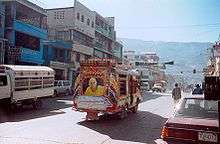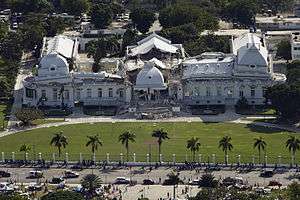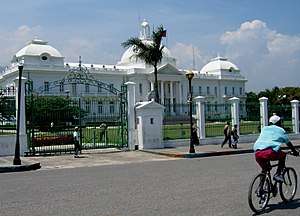Port-au-Prince
Understand
The city's recent history has been dominated by the aftermath of a devastating earthquake in 2010, which leveled many buildings and left hundred of thousands dead. Reconstruction effects are ongoing but many historic sights have been lost.
Get in
By plane
Port-au-Prince Airport (PAP IATA) is served by several major airlines, primarily Air Canada, JetBlue Airways, American Airlines and United Airlines and smaller flights from the Dominican Republic, Cuba, and other spots in the Caribbean. The Haitian airline Sunrise Airways, in operation since 2010, offers regular scheduled flights to Orlando (2017), Cuba (2016) and Chile (2017) among other locations. Taxis from the airport to your destination in Port-au-Prince will be about US$20 for standard fare. Tap Taps going to all places past the airport will cost about G15-25 (gourdes) (US$0.25-0.50) and a community-created route map can be found here.
By car
By bus
From Santo Domingo: Caribe Tours, Capitol Coach Line and Terra Bus each run very modern buses daily to Port-au-Prince, each of the 3 companies departing from their own station along Av. 27 de Febrero. Caribe runs to Pétionville (in the hills above Port-au-Prince) that leaves at 11:00. Most all tickets currently cost US$40 one-way, plus serious tax/border fees of about US$26 and RD$100 (Dominican pesos), depending on the direction. Unfortunately, Caribe Tours' bus drops you off in Pétionville after dark so make prior arrangements with a trustworthy person to meet you and transport you to your lodging.
Another, less expensive option, is to take a guagua (Dominican minibus) from Santo Domingo departing 4 blocks NW of Parque Enriquillo, just West of Av Duarte, from a small parking lot within the elevated expressways of Espresso 27 de Febrero). suggests guava buses leave every 45min, but this is not always the case. Price is RD$400 (about US$10), allow about 5h for the journey including a quick rest/meal sto) and arrive in the border town of Jimani. From there it is a 4km walk or a RD$50+ ride by motoconcho to the border post. The border is apparently open 08:00-18:00 (if it respects its times).
In the past it was very easy to cross the border without submitting to any immigration procedures on either side, and although probably illegal, saved a few dozen dollars in bribes and was much faster too. Things are changing: passport control is now generally required leaving the Dominican Republic, not just entering the DR. Entering Haiti legally is quick: fill out the green form and pay whatever amount the official asks (around RD$100). There are no ATMs at the border. Moneychangers give gourdes for Dominican and US currency. Rates are fair. Protect Haiti's small green card in your passport, allowing you to leave Haiti without risking a penalty.
There's usually plenty of local transportation from the border to Port-au-Prince. Crowded tap-taps and buses can take you to Croix-des-Bouquets for about G75 (1-2h), from where it is another hour to Port-au-Prince (bus, G5+ per route, summary network map. Road ranges from very bad to good, and is prone to flooding. Peruvian UN soldiers at the border have confirmed that the road to Port-au-Prince is safe to travel with no incidents of robbery or kidnappings, but definitely try to arrive in Port-au-Prince before dark.
By boat
Get around

Tap-taps run along prescribed routes throughout the city. Most routes cost G15-25 (US$0.25-0.50), although to get across the city you may need to utilize multiple routes, each of which charges separately.
Street taxis are typically about G500 and should be used only during daylight. After dark, prices rise substantially, and you are at substantially greater risk of being mugged. Street taxis downtown are signified with a red ribbon hanging from their rear-view mirror.
Since 2016 a new branded taxi company arrived on the scene - Premium Rapid (app can be downloaded from iTunes and Google Play stores). Then in 2017, Al's Taxi's opened in the Thomassin area (servicing the whole of PAP). Phone calls only for All's Taxi. Nick's Taxis (fleet of 6-7 yellow cars) can still be found but are looking very dated and tired. These branded taxis all have positive reports for safety and reliability giving visitors and locals more options to get around both during the day and at night.
See


- 🌍 National Palace (Palais National). The National Palace famously collapsed during the earthquake and offers one of Port-au-Prince's most startling reminders of the quake's power. Adjacent to the palace used to be one of Port-au-Prince's many tent cities, whose over 1000 residents occupied what used to be the most beautiful park in Haiti, the Champs-de-Mar, but the residents have now been evicted. As of 2018, the ruins of the palace has been removed and construction of new, identical, palace is to commence.
- 🌍 Cathedral of Our Lady of the Assumption (Cathédrale Notre-Dame de L'Assomption). Port-au-Prince's largest cathedral is just down the road from the palace and is likewise a shell of its former glory. Residents continue to pray outside its broken husk, and funerals are frequently held in a plaza behind the main building.
- 🌍 Musée du Panthéon National Haïtien, Avenue de la République. A museum featuring the heroes of the independence of Haiti and the Haitian history and culture. Individual guided tour through a chronology of Haitian history are avalible. Each period has its own mural and contains paragon items of that time: the anchor of the Santa Maria, Christopher Columbus's flagship, is the centrepiece of the exploration age section. Free entrance, guided tours US$1.
Do
- Audel Marseille, ☎ +509 36523629, e-mail: kethomars@gmail.com. The experienced moto taxi driver will pick you up in your hotel and show you every corner of Port-au-Prince. Audel is fluent in English, French and Spanish and normally charges US$20 for 3-4 hours trip through the city. He will wait while you visit museums and lead you through Marche de Fer.
Buy
Markets
- Marche de Fer (Iron Market) A densely packed market of vendors selling everything from crafts such as voodoo paraphernalia to fresh food such as turtles. It a challenging, stressful, and maddening place to walk through as throngs of desperate merchants grab you and tight huddle of shoppers, stalls, and moving goods impede your every step, which requires you to swim through humanity. You will find a breathtaking inventory of hand crafted art: sculptures, masks, staves, paintings, globes, tea sets, coconut belts, etc.
Banking
There are at least two banks with ATMs: Scotiabank and Sogebank. The closest Scotiabank to downtown is at the intersection of Boulevard Jean-Jacques-Dessalines and Rue Pavée. Even the ATM is closed on Sundays. Banks here close very early, even on the weekdays.
Eat
Eating out in Port-au-Prince is surprisingly expensive. Even at modest restaurants a full plate of food will usually cost around G200. A good amount of food from street vendors will even cost up to G100.
Budget
- Foodies (near the National Palace) A clean fast food joint serving hamburgers and fries. Expect to spend about G120 for a cheeseburger, fries, and drink. Ask for the owner, a Haitian of Lebanese ancestry, who will answer your questions in Brooklyn English.
Mid-range
- Pizza Garden, one of the best pizzerias in the whole city, although it is hard to find if you do not know its location. There is "Old" Pizza Garden and "New" Pizza Garden, the latter being as a result of a split in co-owners. The décor is typical of a Haitian café, with hand crafted tables and lamps. The atmosphere feels intimate due to the soft lighting. Try the extra cheese pizza.
Splurge
Self-catering
There are grocery stores all over town at least two in the centre of town, both located on Capois: the Big Star Market in the Champ-de-Mars area and the Primera Market nearby the Hotel Olafson.
Drink
- Crémas, an alcoholic beverage made of coconut and vanilla.
- Rhum Barbancourt
- Biere Prestige
- bottled water
Sleep
There are no cheap places to stay, just less expensive choices.
Budget
- Palace Hotel. The cheapest hotel in the centrally located Champ-de-Mars. A good choice if you want to stay out late as the hotel is so easy to return to. A faded grand balcony occupies the entire second floor. There is a vintage feeling of being where aristocrats used to hang out. It can be a lonely place as there are almost no other Western travellers. The accommodations are rough: electricity and running water (no hot water) are on and off. The cost of a double can be negotiated down to US$40.
- 🌍 Wall's Guesthouse, Delmas 19, Rue Mackendal 8, ☎ +509 37 03 4788. A clean secure compound popular with missionaries located in Delmas, a residential neighbourhood, far from the action of Port-au-Prince. The electricity is constant and so is the cold water. You may be placed in a room with other people but that is unlikely; however, you will be sharing a bathroom. A buffet-style breakfast and dinner are complementary. If you do not mind the toilsome journey from the guesthouse to interesting parts of Port-au-Prince, then consider the place for US$30 per person.
Mid-range
Splurge
- 🌍 Hotel Oloffson, Ave Christophe 60, ☎ +509 2223-4000. An illustrious hotel with unmistakable past grandeur which has served as a mansion and a marines base and is now a popular hotel for Westerners in Haiti. The guests--such as UN employees, film makers, academics--all mingle easily with the owner, Richard, and each other on the long front desk, which also doubles as a bar/restaurant. If you are travelling with many people, consider a suite; they are huge. Singles from US$70, doubles from US$80.
- 🌍 Karibe Hotel, Juvénat 7, Pétion-Ville. Nestled in the hills above Port-au-Prince, formally within the neighboring city of Pétion-Ville, this hotel offers with excellent views over the city.
- 🌍 Marriott Port-au-Prince Hotel, Ave Jean-Paul II 147. Modern, if somewhat bland, luxury hotel near downtown.
Connect
Stay safe
| WARNING: Some governments advise against nonessential travel to the neighbourhoods of Bel Air, Carrefour, Cité Soleil, and Martissant amid the unstable security situation (criminal activity) in those areas of the city. | |
Government travel advisories
| |
| (Information last updated Sep 2017) |
You should not be outside on the streets after dark unless you are wandering around the busy Champs-de-Mars area. Many travellers and guide books rate Port-au-Prince as the most dangerous major city in the Caribbean in terms of crime and personal safety, even more so than, say, Kingston, Jamaica or Port-of-Spain, Trinidad and Tobago.
Cope
Embassies
Being the national capital, Port au Prince hosts a large number of embassies. A majority of them are clustered in Pétion-Ville in the south part of town. They can also be located in other parts of town too. Other countries maintain (non-resident) diplomatic representation to Haiti through their embassy in Mexico City, Santo Domingo, their UN Mission in New York or elsewhere in the region:













The Embassy of Canada in Haiti is closed as of February 14, 2019, due to civil unrest in Port-au-Prince and throughout the country.
Go next
- Pétionville, a wealthy suburb with lots of nightlife, bars and restaurants.
- Fort Jacques cool air in one of Haiti's few national parks, together with the view, should refresh you; about 45min up a mountain